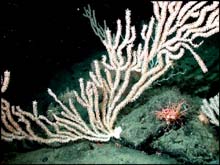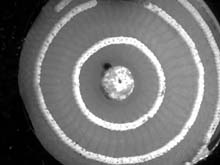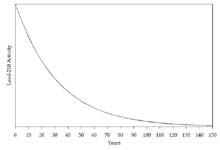There's a rather impressive diversity of animals associated with this bamboo coral (Keratoisis sp.), discovered at 1,455 m depth at Davidson Seamount. Click image for larger view and image credit.
Deep-sea Corals and How to Measure Their Age and Growth
Allen H. Andrews
Research Associate
Moss Landing Marine Laboratories
Andrew DeVogelaere, PhD
Chief Scientist
Davidson Seamount: Exploring Ancient Coral Gardens
Marine Scientist/Research Coordinator
Monterey Bay National Marine Sanctuary
Corals in deep, cold water
When most people think of corals they imagine tropical waters and snorkeling. They are surprised to learn that corals are also found throughout the world in the ice-cold, dark waters of the deep ocean. Cold-water (or deep-sea) corals are part of the taxonomic group called Cnidaria, and they are related to animals like sea anemones and jellyfish. They can live as individuals or as colonies that form extensive reefs. These corals feed by waiting for small food particles to flow past, and then use their stinging cells to capture them. They also provide habitat for other species. These beautiful animals are among the oldest living organisms; some reefs are several thousand years old, and some individual corals live several hundred years.
Radiometric dating
Before researchers can fully understand the importance and sensitivity of these habitat-forming corals of the deep, we need more information about their life history, such as age, growth, and longevity. So far, age determination studies have found that deep-sea corals can attain ages anywhere from a hundred to perhaps thousands of years. Age and growth of deep-sea corals is typically determined from outgrowth studies in the field, growth-zone counts in the skeletal structure, a radiometric technique (e.g., lead-210 dating), or a combination of these techniques.
Scientists used this cross section of bamboo coral, sampled from Davidson Seamount, for lead-210 dating. The series of holes followed circular patterns that could be seen in the growth structure. Age was determined based on the decay of lead-210, from the edge of the cross section to near the center. Click image for larger view and image credit.
Lead-210 dating is a technique that uses the radioactive decay of lead-210 as a "natural clock" that can reveal estimates of age. This process begins with the natural incorporation of lead-210 from seawater into the coral skeleton. As the coral grows like a tree, laying down growth rings, the radioactivity of lead-210 decreases from the youngest to the oldest part of the skeleton. The reason lead-210 activity decreases is because it slowly decays (a process called radioactive decay) at a known rate — in this case, a half-life of 22.26 years. (A half-life is the time elapsed for the radioactivity of a substance to fall to half its original value.) To measure this change in radioactivity and relate it to age, researchers take a series of samples from the edge of a skeletal cross section to the center. By taking this series of lead-210 measurements, they can use the decrease of lead-210 activity to determine the age and growth of the coral. This approach is useful to about 100 years of age at which time the activity of lead-210 decreases to background, or supported, levels.
Coral age estimates
In a recent study, researchers estimated the age of bamboo coral from Davidson Seamount (Andrews et al. 2005a). The results from various growth-zone-counting interpretations led to a wide range of estimated age. For a cross section 8 to 11 mm in radius, estimates of 80 to 220 years were determined for the bamboo coral colony. From a series of lead-210 dating samples taken in that study, and a recent follow up study (Andrews et al. 2005b), support for the older age estimates prevailed. This line of work has been further applied to another species of bamboo coral from New Zealand and related to possible indicators of ocean climate change (Neil et al. 2005, Tracey et al. 2005).
This diagrammatic representation of the decay of lead-210 over time shows that the activity is reduced to half at about 22 years. This trend continues to approach an activity of zero (or supported levels) in an exponential manner. It is this decrease in lead-210 activity that is a measure of age as activity approaches the asymptote (a line whose distance to a given curve tends to zero). Click image for larger view and image credit.
In the current study, researchers will collect additional specimens from Davidson Seamount to better refine estimates of age using lead-210 dating. The aim of this portion of the study is to collect two relatively large colonies, along with a series of upper limbs or tips from colonies, within and between various locations. The two large colonies will be sampled more extensively for lead-210 dating to provide age determinations with minimal uncertainty. The series of colony tips will be used to relate growth rates within and between colonies and locations on the seamount.
References
Andrews, A.H., G.M. Cailliet, L.A. Kerr, K.H. Coale, C. Lundstrom, and A. DeVogleare. 2005a. Investigations of age and growth for three species of deep-sea coral from the Davidson Seamount off central California. In: Cold-water Corals and Ecosystems. A. Freiwald and J.M. Roberts eds. Proceedings of the Second International Symposium on Deep Sea Corals. Erlangen, Germany. September 8 - 13, 2003. pp. 965-982
Andrews, A.H., D.M. Tracey, H. Neil, G.M. Cailliet, and C.M. Brooks. 2005b Abstract: Lead-210 dating bamboo coral (family Isididae) of New Zealand and California. Third International Symposium on Deep-Sea Corals: Science and Management. University of Miami, Florida. November 28 - December 2, 2005.
Tracey, D.M., J.A. Sanchez, H. Neil, P. Marriott, A.H. Andrews, and G.M. Cailliet. 2005. Abstract: Age and growth, and age validation of deep-sea coral family Isididae. Third International Symposium on Deep-Sea Corals: Science and Management. University of Miami, Florida. November 28 - December 2, 2005.
Helen Neil, D.M. Tracey, P. Marriott, R. Thresher, A.H. Andrews, J. Sanchez. 2005. Abstract: Preliminary evidence of oceanic climate change around New Zealand over the last century: the pole-equator seesaw. Third International Symposium on Deep-Sea Corals: Science and Management. University of Miami, Florida. November 28 - December 2, 2005.























